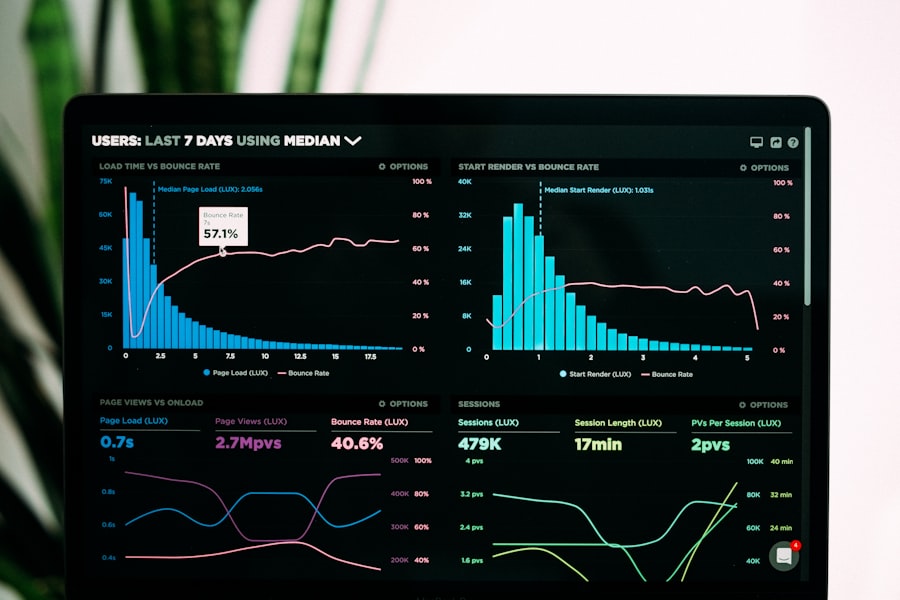
Mastering Stock Market Technical Analysis: A Guide
Technical analysis is a method of evaluating and predicting future price movements in financial markets by analyzing historical price and volume data. The purpose of technical analysis is to identify patterns and trends in the market that can help traders make informed trading decisions. Unlike fundamental analysis, which focuses on the intrinsic value of a security, technical analysis is solely based on the study of price and volume data.
Fundamental analysis involves analyzing a company’s financial statements, industry trends, and economic factors to determine the value of a stock. It takes into account factors such as earnings, revenue, and market share to assess the potential for future growth. Technical analysis, on the other hand, does not consider these fundamental factors. Instead, it focuses on the supply and demand dynamics that drive price movements in the market.
Key Takeaways
- Technical analysis involves analyzing stock market data to identify trends and patterns.
- Charting is an important tool in technical analysis for visualizing market data.
- Identifying trends and patterns can help traders make informed decisions about buying and selling stocks.
- Technical indicators, such as moving averages and relative strength index, can provide additional insights into market trends.
- Volume is an important factor to consider in technical analysis, as it can indicate the strength of a trend or signal a potential reversal.
The Importance of Charting in Technical Analysis
Charting is an essential tool in technical analysis as it allows traders to visualize and interpret price movements over time. There are several types of charts used in technical analysis, including line charts, bar charts, and candlestick charts. Line charts are the simplest form of charting and show only the closing prices over a specified period. Bar charts provide more information by showing the opening, high, low, and closing prices for each period. Candlestick charts are similar to bar charts but use colored bars or “candles” to represent bullish or bearish price movements.
To read and interpret charts, traders look for patterns and trends that can provide insights into future price movements. Trend lines are one of the most basic tools used in charting. They are drawn by connecting a series of higher lows or lower highs to identify an upward or downward trend. Support and resistance levels are also important indicators that show areas where buying or selling pressure is likely to be strong.
The benefits of charting in technical analysis are numerous. By studying historical price patterns, traders can identify potential entry and exit points for trades. They can also use charts to set stop-loss orders to limit potential losses. Additionally, charting allows traders to visualize market trends and make informed decisions based on the current market sentiment.
Identifying Trends and Patterns in Stock Market Data
One of the key aspects of technical analysis is identifying trends in stock market data. Trends can be classified as either uptrends, downtrends, or sideways trends. An uptrend is characterized by a series of higher highs and higher lows, indicating that buyers are in control. A downtrend, on the other hand, is characterized by a series of lower highs and lower lows, indicating that sellers are in control. A sideways trend occurs when the price moves within a range without making significant higher highs or lower lows.
In addition to trend lines, technical analysts also look for chart patterns that can provide insights into future price movements. Some common chart patterns include head and shoulders, triangles, and flags. A head and shoulders pattern is a reversal pattern that indicates a potential trend reversal from bullish to bearish. It consists of three peaks, with the middle peak being the highest (the head) and the other two peaks (the shoulders) being lower. Triangles are continuation patterns that indicate a temporary consolidation before the price continues in the same direction. Flags are also continuation patterns that occur after a strong price move and indicate a brief pause before the price continues in the same direction.
By understanding trend lines and recognizing chart patterns, traders can make more informed trading decisions. Trend analysis allows traders to identify potential entry and exit points based on the direction of the trend. Chart patterns provide additional confirmation of potential trend reversals or continuations.
Using Technical Indicators to Analyze Stock Market Trends
| Technical Indicator | Description | Pros | Cons |
|---|---|---|---|
| Simple Moving Average (SMA) | Average price of a security over a specified time period. | Easy to calculate and interpret. | May lag behind current market trends. |
| Relative Strength Index (RSI) | Measures the strength of a security’s price action. | Can indicate overbought or oversold conditions. | May generate false signals in volatile markets. |
| Bollinger Bands | Measures volatility and potential price breakouts. | Can identify potential buying or selling opportunities. | May not work well in trending markets. |
| Moving Average Convergence Divergence (MACD) | Measures the difference between two moving averages. | Can identify trend changes and potential buy/sell signals. | May generate false signals in choppy markets. |
Technical indicators are mathematical calculations based on historical price and volume data that can help traders analyze stock market trends. There are numerous technical indicators available, but some of the most popular ones include moving averages, the Moving Average Convergence Divergence (MACD), and the Relative Strength Index (RSI).
Moving averages are used to smooth out price data and identify trends. They calculate the average price over a specified period and plot it on a chart. The most commonly used moving averages are the simple moving average (SMA) and the exponential moving average (EMA). The SMA gives equal weight to all data points, while the EMA gives more weight to recent data points.
The MACD is a trend-following momentum indicator that shows the relationship between two moving averages of a security’s price. It consists of two lines – the MACD line and the signal line – as well as a histogram that represents the difference between the two lines. When the MACD line crosses above the signal line, it is considered a bullish signal, indicating that it may be a good time to buy. Conversely, when the MACD line crosses below the signal line, it is considered a bearish signal, indicating that it may be a good time to sell.
The RSI is an oscillator that measures the speed and change of price movements. It ranges from 0 to 100 and is typically used to identify overbought or oversold conditions in a security. When the RSI is above 70, it is considered overbought, indicating that the security may be due for a pullback. When the RSI is below 30, it is considered oversold, indicating that the security may be due for a bounce.
While technical indicators can be useful in confirming trends and identifying potential entry and exit points, they also have limitations and drawbacks. One limitation is that they are based solely on historical price and volume data and do not take into account fundamental factors that can impact a stock’s value. Additionally, technical indicators can generate false signals, leading to poor trading decisions if used in isolation. Therefore, it is important for traders to use technical indicators in conjunction with other forms of analysis and to consider the overall market context.
The Role of Volume in Technical Analysis
Volume is an important factor in technical analysis as it can confirm or contradict price movements. Volume represents the number of shares or contracts traded during a given period. When volume increases significantly during a price move, it indicates strong buying or selling pressure and suggests that the price move is more likely to be sustained.
Volume indicators, such as on-balance volume (OBV) and volume-weighted average price (VWAP), can provide additional insights into market trends. OBV is a cumulative indicator that adds volume on up days and subtracts volume on down days. It is used to confirm the strength of a trend by comparing it to the price movement. If the OBV is rising while the price is also rising, it suggests that buying pressure is increasing and the trend is likely to continue. Conversely, if the OBV is falling while the price is rising, it suggests that selling pressure is increasing and the trend may be weakening.
VWAP is a technical indicator that calculates the average price weighted by volume over a specified period. It is often used by institutional traders to determine the average price at which they bought or sold a security. VWAP can act as a support or resistance level, with prices above VWAP indicating bullish sentiment and prices below VWAP indicating bearish sentiment.
By analyzing volume data and using volume indicators, traders can gain insights into market trends and potential trend reversals. High volume during a price move suggests that the move is more likely to be sustained, while low volume suggests that the move may be weak and prone to reversal.
Applying Technical Analysis to Different Types of Stocks

Technical analysis can be applied to different types of stocks, including growth stocks, value stocks, and dividend stocks. However, it is important to adjust technical analysis strategies for different market conditions and the specific characteristics of each type of stock.
For growth stocks, which are characterized by high earnings growth rates, technical analysis can be used to identify potential entry and exit points based on the stock’s price momentum. Traders may look for stocks that are in an uptrend and have strong relative strength compared to the overall market. They may also use technical indicators such as the RSI to identify overbought or oversold conditions.
For value stocks, which are characterized by low price-to-earnings ratios and other fundamental metrics, technical analysis can be used to identify potential buying opportunities when the stock is trading at a discount to its intrinsic value. Traders may look for stocks that are in a downtrend but show signs of bottoming out, such as bullish chart patterns or positive divergence between price and volume indicators.
For dividend stocks, which are characterized by regular dividend payments, technical analysis can be used to identify potential entry and exit points based on the stock’s dividend yield and price movements. Traders may look for stocks that have a history of increasing dividends and are in an uptrend. They may also use technical indicators such as moving averages to confirm the trend and identify potential entry or exit points.
It is important to note that different types of stocks may require different technical analysis strategies. For example, growth stocks may require more focus on price momentum and relative strength, while value stocks may require more focus on fundamental analysis and identifying undervalued opportunities. Traders should adjust their technical analysis strategies accordingly based on the specific characteristics of each type of stock.
Common Mistakes to Avoid in Technical Analysis
While technical analysis can be a valuable tool for traders, there are some common mistakes that should be avoided. One common mistake is overreliance on technical indicators. While technical indicators can provide useful insights into market trends, they should not be used in isolation. It is important to consider other forms of analysis, such as fundamental analysis and market sentiment, to get a more comprehensive view of the market.
Another common mistake is ignoring fundamental analysis. While technical analysis focuses on price and volume data, fundamental analysis takes into account factors such as earnings, revenue, and market share to assess the value of a stock. Ignoring fundamental analysis can lead to poor trading decisions, as it does not take into account the underlying value of a security.
Failing to adjust strategies for changing market conditions is another common mistake in technical analysis. Market conditions can change rapidly, and what may have worked in the past may not work in the future. It is important to continuously monitor and adjust trading strategies based on current market conditions and trends.
Developing a Trading Strategy Based on Technical Analysis
Developing a trading strategy based on technical analysis involves several steps. The first step is to define your trading goals and objectives. Are you looking for short-term gains or long-term investments? Are you looking for high-risk, high-reward opportunities or more conservative trades? Defining your goals will help guide your trading strategy.
The next step is to identify the time frame that you will be trading in. Are you a day trader, swing trader, or long-term investor? Different time frames require different strategies and indicators. For example, day traders may focus on shorter-term trends and use indicators such as moving averages and RSI to identify potential entry and exit points.
Once you have defined your goals and time frame, you can start developing your trading strategy. This involves selecting the appropriate technical indicators and charting tools that align with your goals and time frame. It also involves setting rules for entering and exiting trades, managing risk, and position sizing.
Risk management is an important aspect of developing a trading strategy based on technical analysis. This involves setting stop-loss orders to limit potential losses and determining the appropriate position size based on your risk tolerance and account size. It is important to only risk a small percentage of your trading capital on each trade to protect against large losses.
Backtesting is another important step in developing a trading strategy. This involves testing your strategy on historical data to see how it would have performed in the past. Backtesting allows you to identify potential flaws or weaknesses in your strategy and make adjustments before risking real money.
Once you have developed your trading strategy, it is important to continuously monitor and refine it based on market conditions and performance. This may involve making adjustments to your indicators, rules, or position sizing. It is also important to keep a trading journal to track your trades and analyze your performance over time.
Combining Technical and Fundamental Analysis for Better Results
While technical analysis and fundamental analysis are often seen as opposing approaches, many successful traders use a combination of both types of analysis to make informed trading decisions. By combining technical and fundamental analysis, traders can get a more comprehensive view of the market and increase their chances of success.
Technical analysis can provide insights into short-term price movements and trends, while fundamental analysis can provide insights into the underlying value of a security. By using both types of analysis, traders can identify potential opportunities that align with both the short-term price movements and the long-term value of a stock.
For example, a trader may use technical analysis to identify an uptrend in a stock and potential entry points based on price patterns and indicators. They may then use fundamental analysis to assess the company’s financial health, industry trends, and competitive position to determine if the stock is undervalued or overvalued. By combining both types of analysis, the trader can make a more informed decision about whether to buy or sell the stock.
There are many successful traders who use a combination of technical and fundamental analysis. For example, Warren Buffett, one of the most successful investors of all time, uses fundamental analysis to identify undervalued stocks with strong growth potential. However, he also considers market trends and price patterns to determine the best time to buy or sell a stock.
Resources for Learning and Improving Technical Analysis Skills
There are many resources available for learning and improving technical analysis skills. Books, websites, and courses can provide valuable insights and strategies for analyzing financial markets.
Some popular books on technical analysis include “Technical Analysis of the Financial Markets” by John J. Murphy, “Japanese Candlestick Charting Techniques” by Steve Nison, and “Technical Analysis Explained” by Martin J. Pring. These books cover a wide range of topics, from basic charting techniques to advanced indicators and strategies.
Websites such as Investopedia, StockCharts, and TradingView also provide a wealth of information on technical analysis. These websites offer tutorials, articles, and tools that can help traders learn and apply technical analysis concepts.
There are also online courses and certifications available for those who want to deepen their knowledge of technical analysis. The Chartered Market Technician (CMT) designation, offered by the Market Technicians Association (MTA), is a globally recognized certification for technical analysts. The CMT program covers a wide range of topics, including charting techniques, technical indicators, and trading strategies.
Continuous learning and improvement are key to becoming a successful technical analyst. It is important to stay up-to-date with the latest trends and developments in technical analysis and to continuously refine your skills and strategies.
In conclusion, technical analysis is a valuable tool for traders in the financial markets. It provides them with a systematic approach to analyzing price patterns, trends, and market behavior. By studying historical price data and using various technical indicators, traders can make informed decisions about when to enter or exit trades. Technical analysis also helps traders identify potential support and resistance levels, which can be used to set stop-loss orders and profit targets. Additionally, technical analysis can be used in conjunction with other forms of analysis, such as fundamental analysis, to gain a more comprehensive understanding of the market. Overall, technical analysis is a powerful tool that can enhance a trader’s ability to make profitable trades and manage risk effectively.
If you’re interested in stock market technical analysis, you may also find this article on Wave Magnets intriguing. It explores the healing power of nature and how naturopathy supports the body’s innate ability to heal. Discover the connection between nature and well-being by reading the article here.
FAQs
What is stock market technical analysis?
Stock market technical analysis is a method of evaluating securities by analyzing statistics generated by market activity, such as past prices and volume.
What is the purpose of stock market technical analysis?
The purpose of stock market technical analysis is to identify trends and patterns in market data that can help investors make informed decisions about buying and selling securities.
What are some common tools used in stock market technical analysis?
Common tools used in stock market technical analysis include charts, moving averages, trend lines, and technical indicators such as the Relative Strength Index (RSI) and Moving Average Convergence Divergence (MACD).
What are the benefits of using stock market technical analysis?
The benefits of using stock market technical analysis include the ability to identify trends and patterns in market data, which can help investors make informed decisions about buying and selling securities. It can also help investors to better understand market behavior and make more accurate predictions about future market movements.
What are the limitations of stock market technical analysis?
The limitations of stock market technical analysis include the fact that it is based solely on historical market data and does not take into account other factors that may affect market behavior, such as economic or political events. Additionally, technical analysis can be subjective and open to interpretation, which can lead to different conclusions among analysts.

















